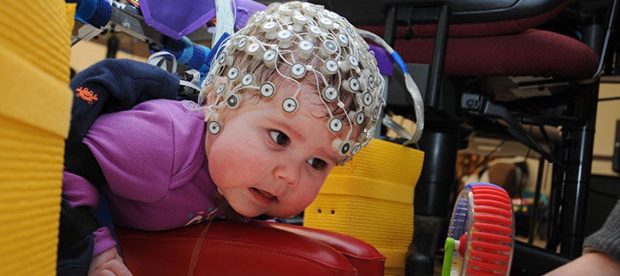Robot Can Help Prevent Cerebral Palsy In Infants
A team of biomedical engineers at University of Oklahama is working on a solution that will help prevent Cerebral Palsy in infants. The team has created a robot called Self-Initiated Prone Progression Crawler (SIPPC; pronounced sip-see) that has power steering, a sophisticated machine learning algorithm, movement sensors, and a cap that has lots of electrodes for tracking brain activity.
The infant is attached to the robot, whose arms roll on three wheels and has several movement sensors. She also wears the electrodes studded cap which sends brain activity to a computer. Her body movement is tracked by the sensors and sent to the attached computer, and if it is determined that she is trying but is not getting the desired movement, the robot gives her a gentle nudge to keep the body movement going, thus rewarding her attempt. The computer, through it’s machine learning algorithm, directs the robot to assist the infant. For example, if she pushes with her back feet to move ahead but doesn’t generate the necessary force, the robot gently pushes her a few inches ahead to obtain the desired movement.
There can be several reasons for the onset of Cerebral Palsy in toddlers, including brain damage during birth, infection, and trauma. One of the members of this team came up with a method to predict if an infant will develop Cerebral Palsy or not way before it is typically detected. Usually it is detected by the first birthday of the infant, however, it starts developing between ages 2 and 8 months, right when they are supposed to start kicking, moving and crawling. These movements are not only necessary to develop motor skills but also for the development of the brain. Crawling is especially important because through crawling not only do they explore what’s around them, but also develop cognitive skills and depth perceptions. Infants with Cerebral Palsy cannot move the way they would like to, and usually start crawling by the age of 2. Since crawling is a reward based process, not getting the desired results, and the inability to move the way they would like to eventually makes the infants to stop trying, which ultimately results in the brain pruning those motor skills.
The team hass now begun this study (which has another 6 to 9 months to go) with 56 infants in the age range of 4 to 8 months. Each session generates around 10 gigabytes of data, and they have done around 1,000 sessions already. They would certainly need some time to digest and understand all that data!


Cerebral Palsy is the actual brain injury or condition. It is not appropriate to say “prevent it.” It would more accurate to say this could minimize the motor affects, if any, of Cerebral Palsy. I would agree that lack of movement does reduce learning and desire and this encouragement could directly serve to encourage drive to move and explore and perhaps assist in development of more normal motor movements as well as intellectual capabilities. Be careful when you suggest a therapy can prevent an injury that has already occurred or is already present. It’s the effects and degree of those affects you are apparently seeking to alieviate. It’s important people fully understand the condition of Cerebral Palsy which a broad name for a wide array of affects sometimes including some or all motoric movements. It is critical for families to fully understand their specific child’s condition so they can seek immediate proper help and assistance as soon as possible to assure the best outcome for this child. Early intervention is everything. This includes all areas of potential impact.